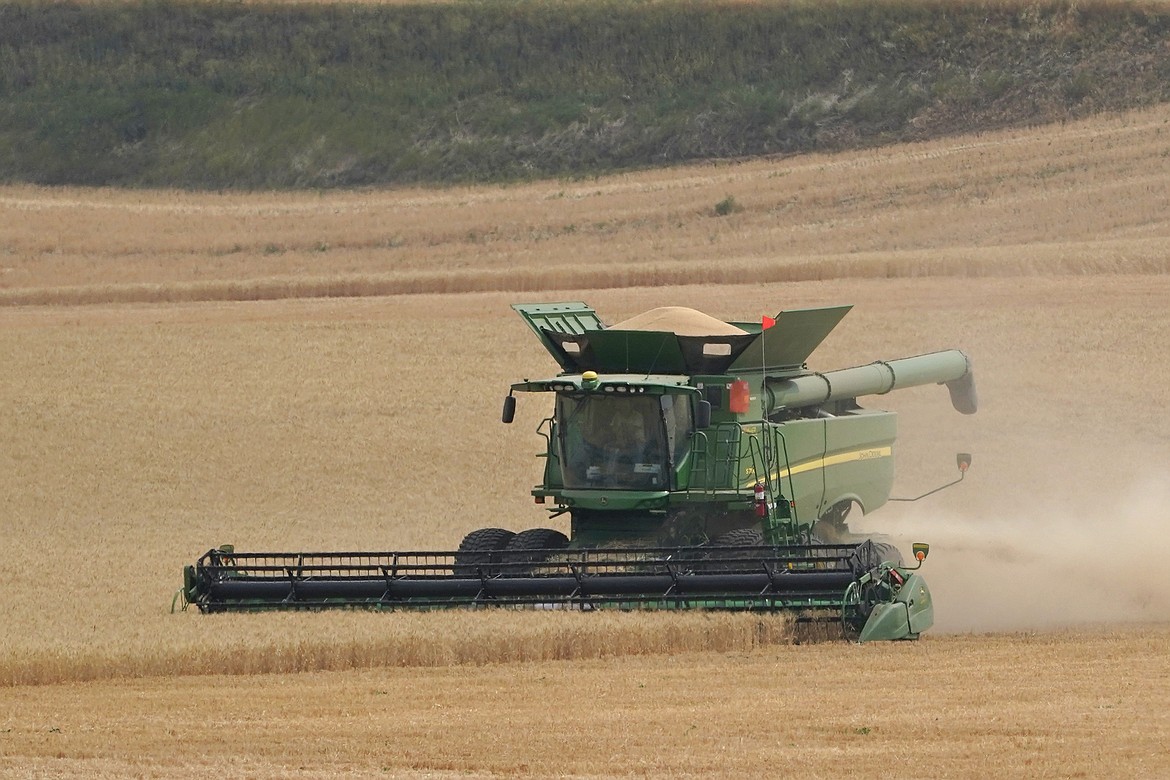Wheat, barley harvests hit hard by drought
MOSES LAKE — The scorched and desiccated dryland wheat in parts of the Columbia Basin earlier this year were an indication of what a lot of farmers probably suspected — the worst wheat harvest in Washington in almost 60 years.
“This is a pretty tough year for wheat farmers,” said Joe Bippert, program director for the Washington Grain Commission in Spokane. “We last had production this low in 1964.”
According to the U.S. Department of Agriculture’s annual Small Grains 2021 Summary, which was published on Sept. 30, while overall wheat acres sown in Washington in 2021 remained relatively unchanged from 2020 at just above 2.3 million acres, yields in 2021 plummeted to 39.1 bushels per acre from 72.4 in 2020, prompting total wheat production in 2021 to fall by nearly 50% to 87.1 million bushels from 166 million bushels in 2020.
Chris Mertz, director of the northwest region for the USDA’s National Agricultural Statistics Service in Portland, wouldn’t directly attribute the decline to the drought. But he did say the lack of rainfall during the spring and summer didn’t help, either.
“Obviously, we did not get the moisture we needed,” Mertz said. “In other years, we had timely rain.”
Bippert said the rain stopped falling at the worst possible time, just as farmers were planting spring wheat.
“Timing is important,” Bippert said. “There was not enough moisture.”
Bippert also said the heat wave in late June and early July — temperatures in the Columbia Basin hit as high as 115 degrees — prompted a lot of the dryland wheat to mature too early.
“It didn’t get to the right height,” he said. “It didn’t get to sit and be green and fill the kernels.”
That means grain that is smaller, higher in protein and yields less, Bippert explained.
And the USDA data reflects that, noting spring wheat — wheat planted in the early spring, as opposed to winter wheat, which is planted in the late autumn — across the region took a bigger hit from the drought than winter wheat, which at least had a little snowmelt to provide moisture.
Spring wheat production in 2021 was 16 million bushels, half of 33.2 million in 2020, with yields also falling by more than half to 30 bushels-per-acre in 2021 from 61 bushels-per-acre in 2020.
Winter wheat harvests and yields in Washington suffered, as well, however, falling to 70.9 million bushels at 42 bushels-per-acre in 2021 from 133 million bushels at 76 bushels-per-acre in 2020.
The heat and drought also affected the region’s barley harvest as well. According to the USDA, while Washington farmers planted around 70,000 acres in 2021 — down from 90,000 in 2020 — to 2021 harvest and yield plummeted to 2.6 million bushels at 38 bushels-per-acre from 6.4 million bushels at 90 bushels-per-acre in 2020.
Mertz added, however, 2020 yield was something of an anomaly, with recent yields in Washington state normally around 70 bushels-per-acre.
Still, he said it was the lowest barley harvest in Washington since 1977.
Bippert said when combined with strong demand, prices for the Pacific Northwest’s soft white wheat have nearly doubled to around $10 per-bushel at the beginning of October from an average of $5.87 per-bushel in October 2020.
According to Bippert, the low harvest comes after several years of strong demand, so grains stocks coming into 2021 were already lower than normal.
“The market is doing what the market does,” he said.
“Some producers were able to take advantage of higher prices, if they had wheat to sell,” Mertz said. “There’s a lot less wheat to sell.”
Much of the Pacific Northwest’s wheat crop is soft white wheat — as opposed to hard red wheat, which is grown in the country’s Midwest breadbasket and had a much better year, according to USDA statistics — and is exported to Asia, where it is used to make noodles, as well as higher value products like cookies, crackers and spongy cakes.
Bippert said the wheat and barley that did survive the year is much higher in protein, which means it’s not as useful for Asian food processors.
“We didn’t have a lot of low-protein wheat this year, so we’re working with Japan on what they can get away with,” he said.
However, Bippert noted the major Asian buyers of Pacific Northwest grain — Japan, Taiwan, South Korea — primarily buy based on the quality of grain, and not so much on price, and so they are looking to meet the demands of their customers regardless of the price.
“There’s still anticipation they will buy,” he said.
Bippert also said some farmers have told him the region’s surviving barley is too high in protein to make beer, and much of those crops are being sold for animal feed.
“The quality is not there to get it to malt,” he said.
Malting involves soaking a grain — typically barley, though wheat, sorghum and rye can also be malted — and allowing it to germinate, then drying and roasting the grain. The germination releases enzymes that use protein and allow for the breaking down of starches and their conversion into sugars, which yeast then converts to alcohol during fermentation.
Charles H. Featherstone can be reached at [email protected].


